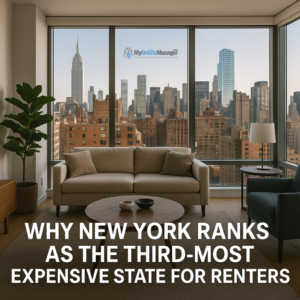Renting a home in the U.S. has never been more challenging. Across the nation, renters are finding it harder to secure affordable housing as costs rise faster than wages. According to the latest Out of Reach Report from the National Low Income Housing Coalition, New York is now the third-most expensive state for renters, behind only California and Hawaii.
This ranking highlights not just New York’s notorious rental market but also a broader national crisis where even a full-time minimum wage job is not enough to cover the cost of modest housing anywhere in the country.
(Source: WJFF Radio)
How Much Does Rent Really Cost in New York?
-
The fair market rent (FMR) for a modest two-bedroom apartment in New York is about $2,400/month.
-
To afford this without spending more than 30% of income on rent (the federal affordability standard), a household must earn nearly $100,000 annually.
-
By contrast, a worker earning New York’s minimum wage of $15.50/hour can afford only about $800/month in rent.
That means the average renter at minimum wage would need to hold three full-time jobs just to cover the cost of a two-bedroom unit.
Regional Realities: Beyond NYC
It’s easy to assume these figures are skewed by Manhattan or Brooklyn rents. But affordability problems are not limited to New York City:
-
Upstate New York (Monroe County) – The fair market rent for a two-bedroom apartment is around $1,500/month. A renter would need to earn about $20/hour to afford this still far above minimum wage.
-
Suburban Counties (e.g., Westchester, Nassau, Suffolk) – Rents are among the highest in the state, often exceeding $3,000/month for family-sized apartments.
-
Rural Counties – Even in non-metropolitan areas, wages are not keeping up with local rents, leaving renters in smaller towns just as burdened.
This shows that the crisis is not just an urban issue it’s statewide.
A Nationwide Problem: No State is Affordable
The situation in New York mirrors a grim reality nationwide. The report emphasizes that:
-
No U.S. state, city, or county has a rental market where a full-time minimum wage worker can afford a modest two-bedroom apartment.
-
Even for a one-bedroom apartment, most states require renters to earn more than minimum wage.
-
Hawaii tops the list with the highest “housing wage” the hourly pay needed to afford rent followed by California, then New York.
This paints a picture of a country where low-income and even middle-income families are being priced out of stable housing.
Why Are Rents So High?
Several factors are fueling the housing crisis in New York and across the nation:
-
Housing Supply Shortages
-
New construction hasn’t kept pace with demand, especially in high-growth job centers like New York City.
-
Restrictive zoning and permitting processes slow down development.
-
-
Rising Construction & Maintenance Costs
-
Inflation has pushed up the cost of building materials and labor.
-
Landlords pass these costs onto tenants through higher rents.
-
-
Income Stagnation
-
While rents have surged, wages particularly at the lower end of the income scale have not kept up.
-
The result: a growing affordability gap.
-
-
High Demand in Metro Areas
-
New York City attracts millions of workers, students, and immigrants, creating fierce competition for limited housing stock.
-
The Human Impact: Rent Burden & Homelessness
High rents don’t just hurt wallets they destabilize communities.
-
Rent-Burdened Households: A household is “rent-burdened” when it spends more than 30% of its income on rent. In New York, nearly half of all renters fall into this category.
-
Severe Rent Burden: Households spending more than 50% of their income on rent are at even greater risk. This leaves little for food, healthcare, or savings.
-
Risk of Homelessness: Advocates warn that cuts to federal housing assistance programs could lead to a surge in homelessness, particularly in cities already struggling with shelter capacity.
What Can Be Done? Policy & Community Solutions
Experts and housing advocates argue that meaningful change requires a mix of policy, community, and market solutions.
-
Zoning Reform
-
Allowing more multifamily and mixed-use developments near transit hubs could increase supply.
-
Encouraging accessory dwelling units (ADUs) in suburban and rural communities.
-
-
Incentives for Affordable Housing
-
Tax credits and subsidies for developers who build affordable units.
-
Public-private partnerships to encourage mixed-income housing developments.
-
-
Tenant Protections
-
Expanding rent stabilization laws beyond older units.
-
Strengthening eviction protections to reduce displacement.
-
-
Federal & State Assistance
-
Maintaining and expanding housing voucher programs.
-
Investing in public housing repairs and new affordable housing projects.
-
Looking Ahead: What Renters Should Watch For
While large-scale solutions will take time, renters should pay attention to:
-
Local Housing Legislation: Many city councils in New York are considering zoning changes or tenant protection measures.
-
Statewide Initiatives: Proposals for expanding affordable housing construction remain a political priority in Albany.
-
National Policy Shifts: Any cuts (or expansions) to federal housing programs will directly impact affordability.
Conclusion: A Call for Action
New York’s ranking as the third-most expensive state for renters is more than just a statistic it’s a reflection of how deeply the affordability crisis affects everyday families. With minimum wage workers unable to afford even modest apartments, the housing market is failing the very people who keep the state running.
Without bold policy reforms and investment in affordable housing, the gap between wages and rent will only widen. And as New York shows, this isn’t just an urban problem it’s a statewide and nationwide emergency.
Source
“New York is the Third Most Expensive State for Renters Behind California and Hawaii,” WJFF Radio – Read the full article here

